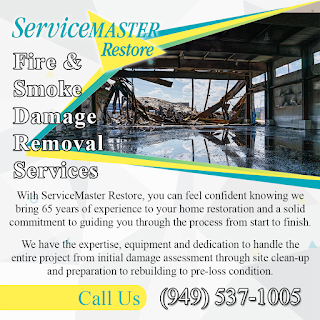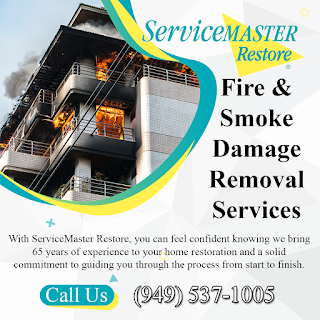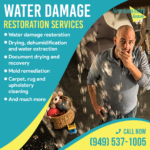When a fire disaster strikes, ServiceMaster Advanced Restoration responds on the scene to assess the damage and provide the services that begin the process leading to restoration, repair, and recovery. The compassionate and dedicated team of professionals endeavors to start and finish the fire and water damage restoration as quickly as possible. A fire damage incident is complex and involves not just fire damage but also smoke damage, soot damage, water damage, and extensive structural damage depending on the size and severity of the incident. Fire scenes are loaded with chemical toxins from the combustibles involved in the fire. If the fire department puts out the fire, additional water damage and structural damage factor into the restoration equation. If the water damage is not immediately mitigated, advanced secondary damage and mold infestation may occur. Because of the danger to life and the destructive nature of a house fire, home fire safety awareness is crucial.
The COVID-19 pandemic has revitalized life in and around the home. The economic shutdown, restrictions on social gatherings, social distancing, sheltering in place, quarantines, remote work, and the virtual school have caused a paradigm shift that is more home-centered. Exercise, entertainment, and leisure are now focused around the home, including both indoor and outdoor living spaces. Pools, spas, grills, landscape lighting, and outdoor kitchens have skyrocketed in popularity.
With this re-orientation toward the home, outdoor fire pits have also ascended in popularity. Basking in the gentle warmth of an outdoor fire pit at the end of a long day can be both relaxing and invigorating, as long as the fire remains contained within the safe confines of the fire pit.
Ensuring that a fire is safely contained is of paramount importance. In 2020, approximately 8,500 fire incidents have consumed over four million acres and damaged or destroyed more than 9,300 structures. Here are some fire pit regulations and safety tips that can help make the experience relaxing, enjoyable, and safe!
Is it legal to have a backyard fire pit in California? Fire pits are legal in most California cities; however, each city in Southern California has differing building codes for constructing fire pits. Non-residential fire pits have additional restrictions to ensure a higher degree of safety. Anyone planning to build a permanent fire pit or purchase and install a movable fire pit should check the local laws before building. Propane and natural gas are a more environmentally friendly alternative to wood burning fire pits.
The following regulations are from the Orange County Fire Authority Fire Prevention Department:
Requirements for Gas Burning Flames Only
- These devices shall not be allowed within three feet horizontally from combustible construction, and the 3-foot separation extends vertically into an atmospheric column, not allowing combustible construction above the device within the column unless a permanent Building Department approved method of venting is installed.
- Other than one- and two-family dwellings, such devices shall not be installed within 10 feet from buildings.
- Site Plan and Form Submittal is not required: For a Building Department approved device meeting the above requirements, designed only to burn a gas flame and not the burning of wood or other solid fuels.
- Site Plan and Form Submittal is required: For the burning of wood or other solid fuels in a Fireplace, Firepit, Fire Ring, or similar device. (The plan is required to show the proximity measured in feet from the proposed device to all structures, fences, property lines, and slopes in or adjoining the yard. When there is more than one device, they are required to be numbered.)
Homeowners who are considering building a permanent fire pit or installing a portable fire pit should be aware of the above ordinances. The ordinances are designed with the safety of people, animals, property, and the forest in mind.
Basic Fire Pit Safety
Keep the following tips in mind when enjoying a backyard fire pit.
Tip #1: Locate the fire pit on level ground. A movable fire pit needs to be stabilized on level ground so that it does not tip over. The level ground around the fire pit also helps prevent people from tripping and falling onto or into the pit.
Tip #2: Position the fire pit ten to twenty feet away from plants and other flammable objects. This precaution reduces the likelihood that sparks or flames will ignite nearby materials and cause an uncontained fire that could lead to extensive fire damage to nearby property.
Tip #3: Do not use a fire pit underneath an overhang. Enjoying a fire pit under a combustible pergola or other covering could result in the structure catching fire.
Tip #4: Keep a bucket of sand, a garden hose, or a fire extinguisher on hand in case of an emergency.
Tip #5: Do not use a wood-burning fire pit on a deck or patio.
Following these basic tips can ensure a relaxing, enjoyable, and safe experience around the backyard fire pit!
When fire damage, water damage, flood damage, or other property damage disaster strikes a home or business, ServiceMaster is poised to respond around the clock. Seeing a home and its precious contents consumed by fire is one of the most traumatic experiences a homeowner can face. After such a devastating loss, reassurance is found in receiving clear guidance and support. At ServiceMaster Advanced Restoration, technicians are more than talented professionals. They are caring people intent on getting the homeowner back in the home as quickly as possible while communicating with the client every step of the way.
For more information about fire damage restoration in Orange County and the surrounding area, contact the office by phone at (949) 537-1005.



